Abstract
Human mitochondrial aldehyde dehydrogenase (ALDH-I) is potently, reversibly, and selectively inhibited by an isoflavone isolated from Radix puerariae and identified as daidzin, the 7-glucoside of 4',7-dihydroxyisoflavone. Kinetic analysis with formaldehyde as substrate reveals that daidzin inhibits ALDH-I competitively with respect to formaldehyde with a Ki of 40 nM, and uncompetitively with respect to the coenzyme NAD+. The human cytosolic aldehyde dehydrogenase isozyme (ALDH-II) is nearly 3 orders of magnitude less sensitive to daidzin inhibition. Daidzin does not inhibit human class I, II, or III alcohol dehydrogenases, nor does it have any significant effect on biological systems that are known to be affected by other isoflavones. Among more than 40 structurally related compounds surveyed, 12 inhibit ALDH-I, but only prunetin and 5-hydroxydaidzin (genistin) combine high selectivity and potency, although they are 7- to 15-fold less potent than daidzin. Structure-function relationships have established a basis for the design and synthesis of additional ALDH inhibitors that could both be yet more potent and specific.
Full text
PDF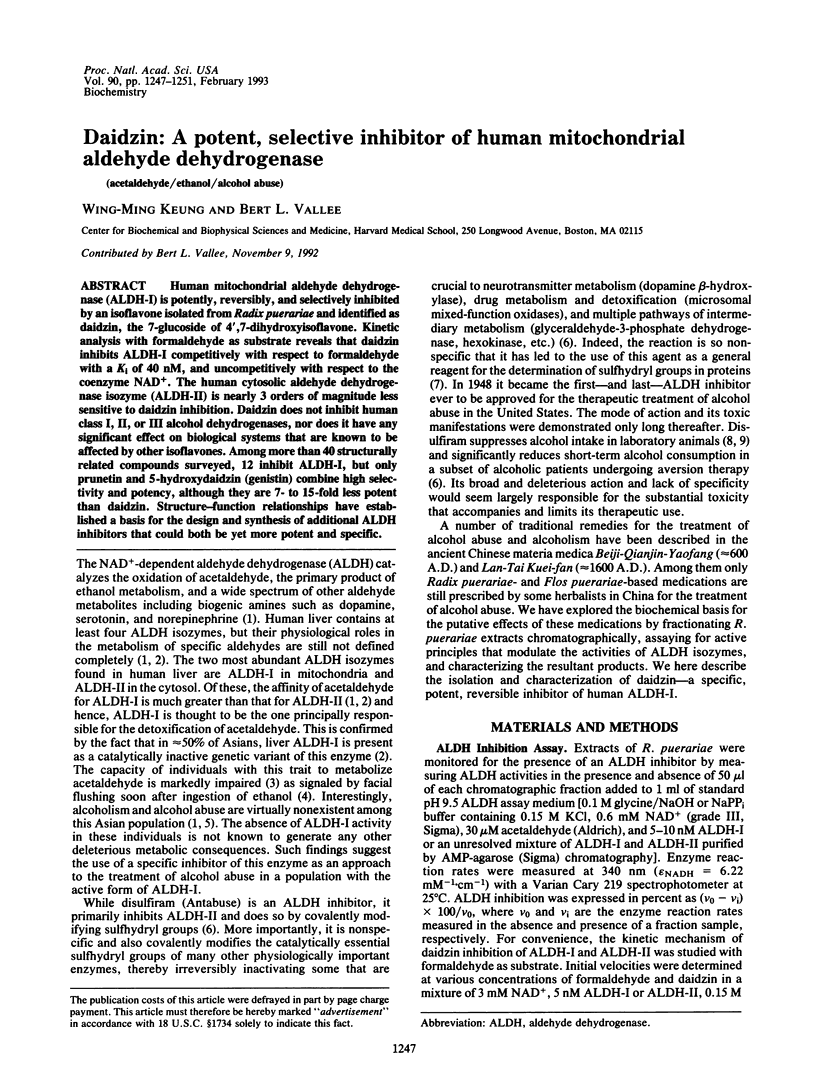
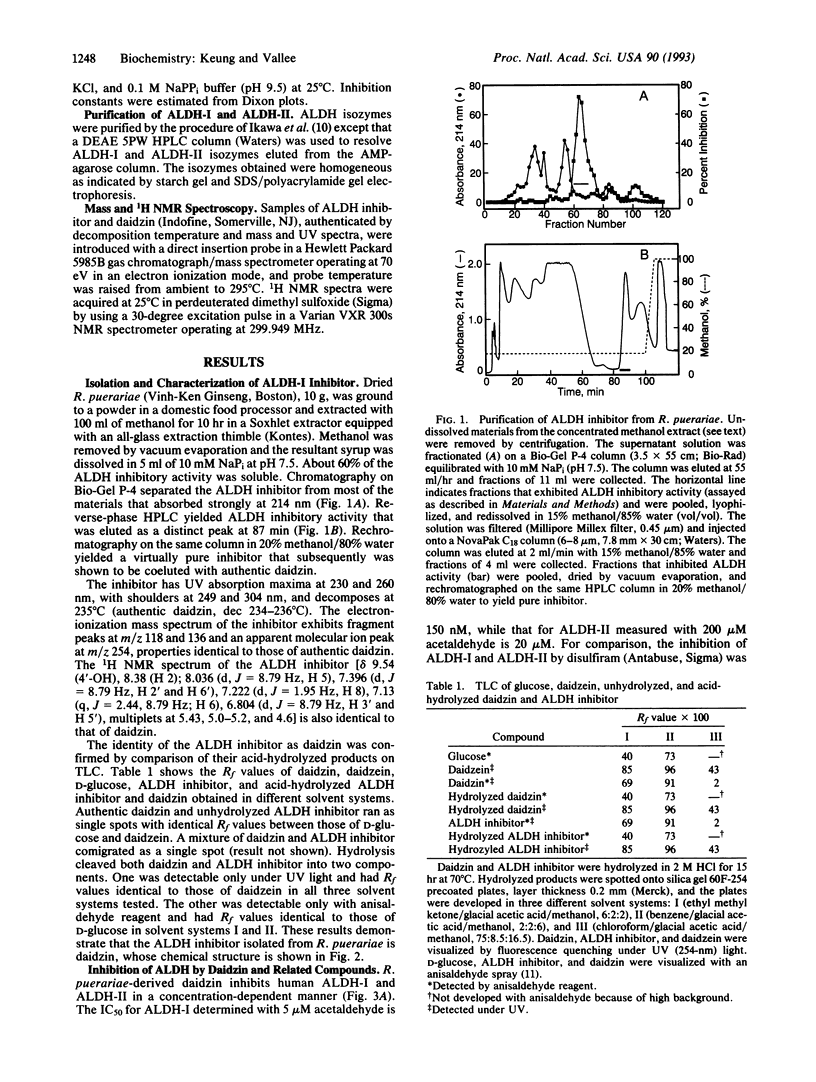
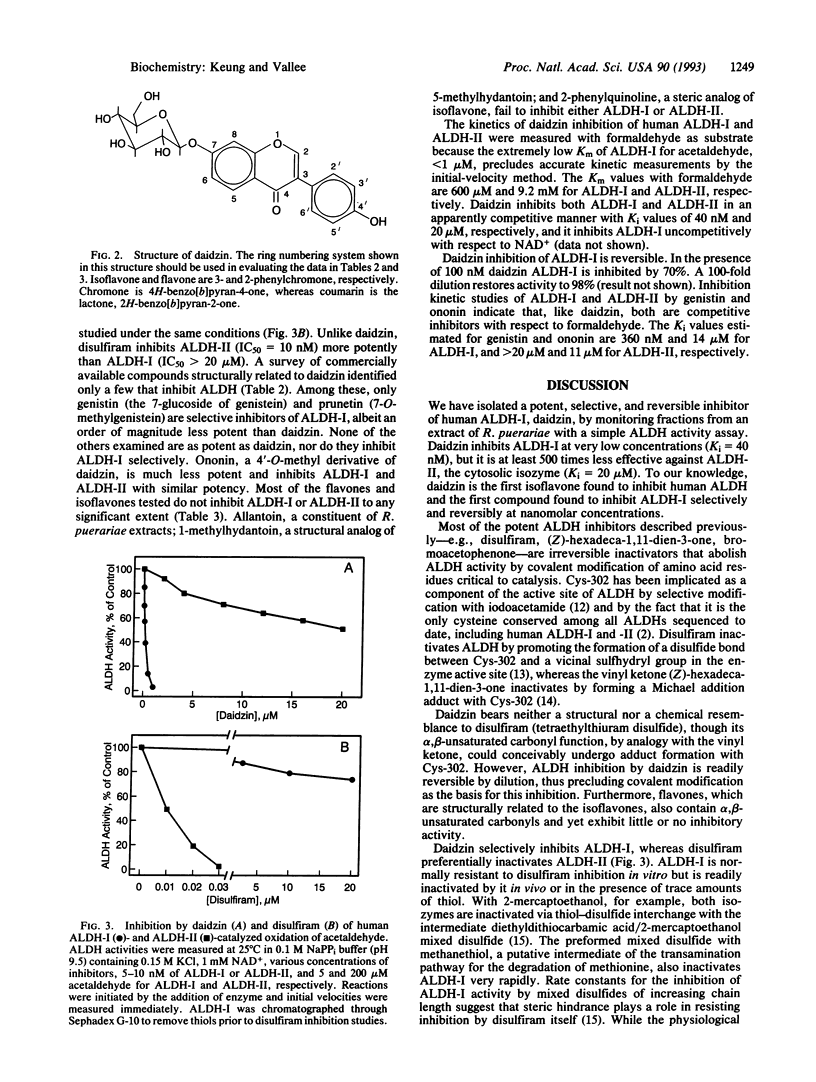
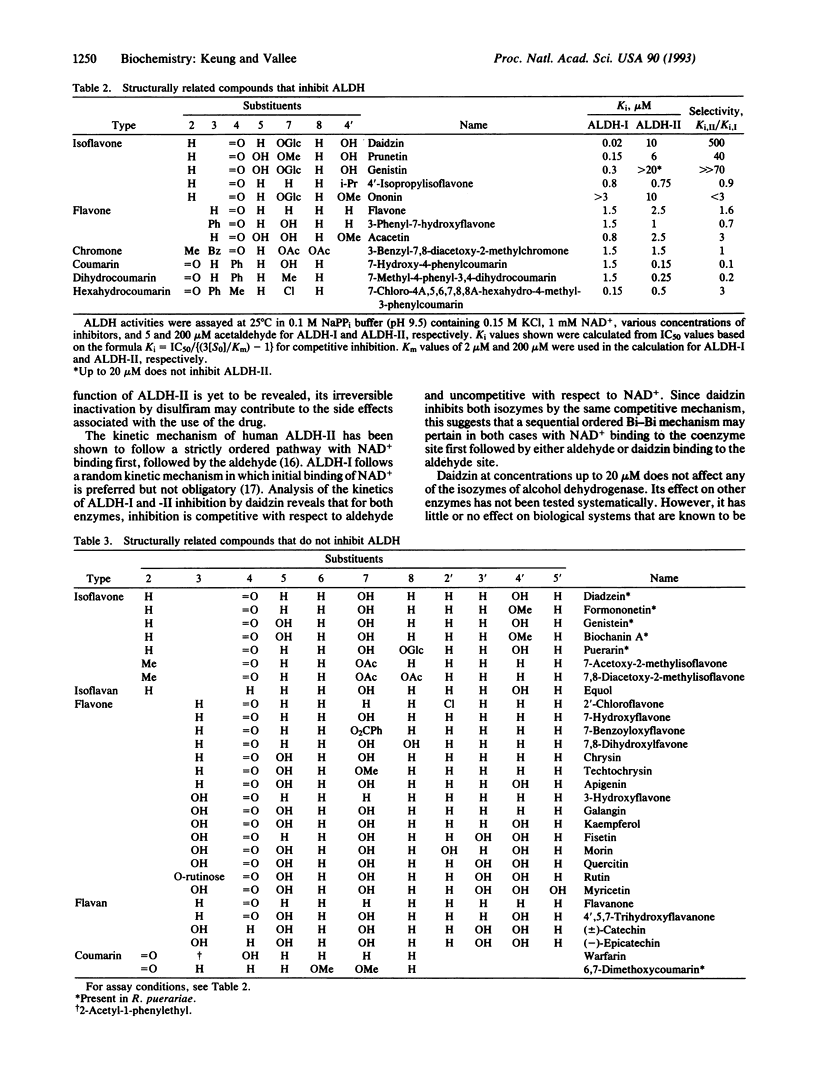
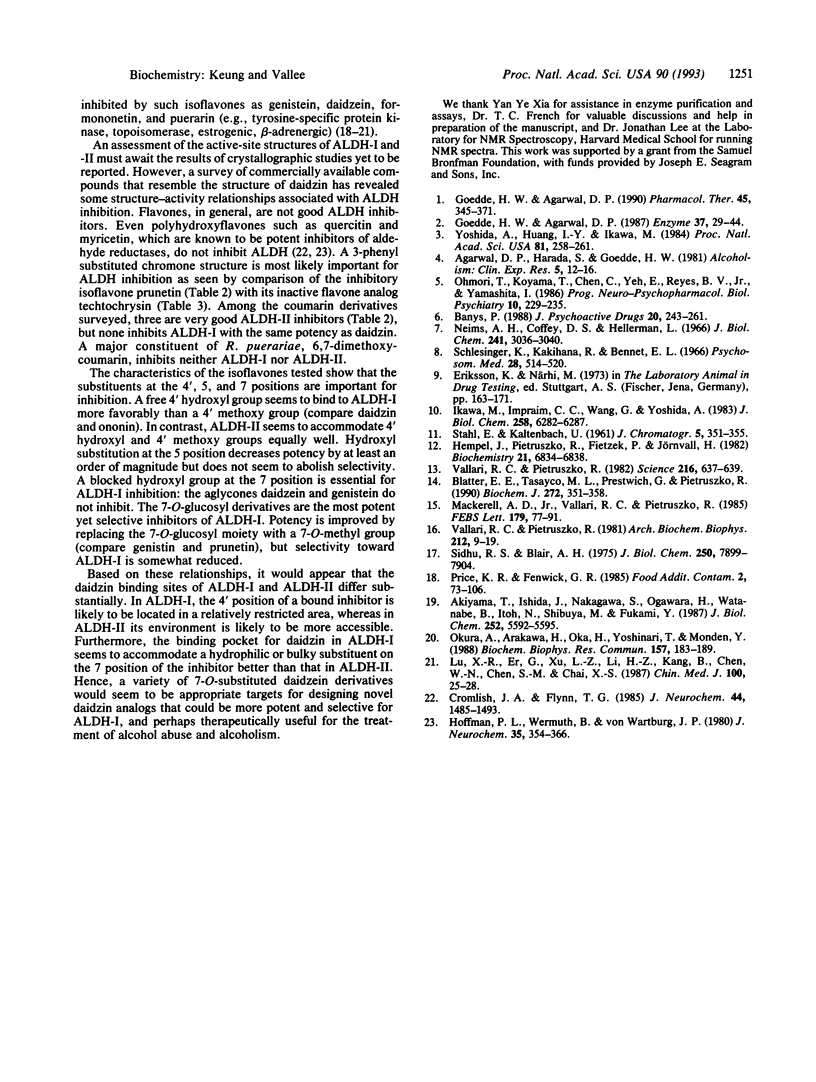
Selected References
These references are in PubMed. This may not be the complete list of references from this article.
- Agarwal D. P., Harada S., Goedde H. W. Racial differences in biological sensitivity to ethanol: the role of alcohol dehydrogenase and aldehyde dehydrogenase isozymes. Alcohol Clin Exp Res. 1981 Jan;5(1):12–16. doi: 10.1111/j.1530-0277.1981.tb04858.x. [DOI] [PubMed] [Google Scholar]
- Akiyama T., Ishida J., Nakagawa S., Ogawara H., Watanabe S., Itoh N., Shibuya M., Fukami Y. Genistein, a specific inhibitor of tyrosine-specific protein kinases. J Biol Chem. 1987 Apr 25;262(12):5592–5595. [PubMed] [Google Scholar]
- Banys P. The clinical use of disulfiram (Antabuse): a review. J Psychoactive Drugs. 1988 Jul-Sep;20(3):243–261. doi: 10.1080/02791072.1988.10472495. [DOI] [PubMed] [Google Scholar]
- Blatter E. E., Tasayco M. L., Prestwich G., Pietruszko R. Chemical modification of aldehyde dehydrogenase by a vinyl ketone analogue of an insect pheromone. Biochem J. 1990 Dec 1;272(2):351–358. doi: 10.1042/bj2720351. [DOI] [PMC free article] [PubMed] [Google Scholar]
- Cromlish J. A., Flynn T. G. Identification of pig brain aldehyde reductases with the high-Km aldehyde reductase, the low-Km aldehyde reductase and aldose reductase, carbonyl reductase, and succinic semialdehyde reductase. J Neurochem. 1985 May;44(5):1485–1493. doi: 10.1111/j.1471-4159.1985.tb08786.x. [DOI] [PubMed] [Google Scholar]
- Goedde H. W., Agarwal D. P. Pharmacogenetics of aldehyde dehydrogenase (ALDH). Pharmacol Ther. 1990;45(3):345–371. doi: 10.1016/0163-7258(90)90071-9. [DOI] [PubMed] [Google Scholar]
- Goedde H. W., Agarwal D. P. Polymorphism of aldehyde dehydrogenase and alcohol sensitivity. Enzyme. 1987;37(1-2):29–44. doi: 10.1159/000469239. [DOI] [PubMed] [Google Scholar]
- Hempel J., Pietruszko R., Fietzek P., Jörnvall H. Identification of a segment containing a reactive cysteine residue in human liver cytoplasmic aldehyde dehydrogenase (isoenzyme E1). Biochemistry. 1982 Dec 21;21(26):6834–6838. doi: 10.1021/bi00269a032. [DOI] [PubMed] [Google Scholar]
- Hoffman P. L., Wermuth B., von Wartburg J. P. Human brain aldehyde reductases: relationship to succinic semialdehyde reductase and aldose reductase. J Neurochem. 1980 Aug;35(2):354–366. doi: 10.1111/j.1471-4159.1980.tb06272.x. [DOI] [PubMed] [Google Scholar]
- Ikawa M., Impraim C. C., Wang G., Yoshida A. Isolation and characterization of aldehyde dehydrogenase isozymes from usual and atypical human livers. J Biol Chem. 1983 May 25;258(10):6282–6287. [PubMed] [Google Scholar]
- Lu X. R., Gao E., Xu L. Z., Li H. Z., Kang B., Chen W. N., Chen S. M., Chai X. S. Puerarin beta-adrenergic receptor blocking effect. Chin Med J (Engl) 1987 Jan;100(1):25–28. [PubMed] [Google Scholar]
- MacKerell A. D., Jr, Vallari R. C., Pietruszko R. Human mitochondrial aldehyde dehydrogenase inhibition by diethyldithiocarbamic acid methanethiol mixed disulfide: a derivative of disulfiram. FEBS Lett. 1985 Jan 1;179(1):77–81. doi: 10.1016/0014-5793(85)80195-2. [DOI] [PubMed] [Google Scholar]
- Neims A. H., Coffey D. S., Hellerman L. A sensitive radioassay for sulfhydryl groups with tetraethylthiuram disulfide. J Biol Chem. 1966 Jul 10;241(13):3036–3040. [PubMed] [Google Scholar]
- Ohmori T., Koyama T., Chen C. C., Yeh E. K., Reyes B. V., Jr, Yamashita I. The role of aldehyde dehydrogenase isozyme variance in alcohol sensitivity, drinking habits formation and the development of alcoholism in Japan, Taiwan and the Philippines. Prog Neuropsychopharmacol Biol Psychiatry. 1986;10(2):229–235. doi: 10.1016/0278-5846(86)90077-1. [DOI] [PubMed] [Google Scholar]
- Okura A., Arakawa H., Oka H., Yoshinari T., Monden Y. Effect of genistein on topoisomerase activity and on the growth of [Val 12]Ha-ras-transformed NIH 3T3 cells. Biochem Biophys Res Commun. 1988 Nov 30;157(1):183–189. doi: 10.1016/s0006-291x(88)80030-5. [DOI] [PubMed] [Google Scholar]
- Price K. R., Fenwick G. R. Naturally occurring oestrogens in foods--a review. Food Addit Contam. 1985 Apr-Jun;2(2):73–106. doi: 10.1080/02652038509373531. [DOI] [PubMed] [Google Scholar]
- Sidhu R. S., Blair A. H. Human liver akdehyde dehydrogenase. Kinetics of aldehyde oxidation. J Biol Chem. 1975 Oct 10;250(19):7899–7904. [PubMed] [Google Scholar]
- Vallari R. C., Pietruszko R. Human aldehyde dehydrogenase: mechanism of inhibition of disulfiram. Science. 1982 May 7;216(4546):637–639. doi: 10.1126/science.7071604. [DOI] [PubMed] [Google Scholar]
- Vallari R. C., Pietruszko R. Kinetic mechanism of the human cytoplasmic aldehyde dehydrogenase E1. Arch Biochem Biophys. 1981 Nov;212(1):9–19. doi: 10.1016/0003-9861(81)90338-6. [DOI] [PubMed] [Google Scholar]
- Yoshida A., Huang I. Y., Ikawa M. Molecular abnormality of an inactive aldehyde dehydrogenase variant commonly found in Orientals. Proc Natl Acad Sci U S A. 1984 Jan;81(1):258–261. doi: 10.1073/pnas.81.1.258. [DOI] [PMC free article] [PubMed] [Google Scholar]


